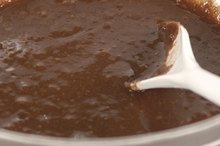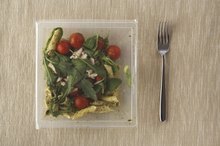Food Poisoning Culprits: Sprouts and 7 Other Risky Foods
Each year a staggering 48 million people get sick from foodborne illnesses, according to the Centers for Disease Control and Prevention (CDC). Most people have milder symptoms like an upset stomach or nausea, but an estimated 128,000 people are hospitalized because of severe symptoms like vomiting, diarrhea and dehydration, and 3,000 lose their lives. Some illnesses can result in long-term health problems like chronic arthritis, brain and nerve damage and hemolytic uremic syndrome (HUS), which causes kidney failure. Scary, right?
If you are experiencing serious medical symptoms, seek emergency treatment immediately.
That's why it's so important to be aware of the foods that are more likely to be contaminated with harmful bacteria than others. Here are eight foods most likely to cause food poisoning as well as expert tips from Susanna Sullard RN, BSN, CIC, infection preventionist at UCHealth Memorial Hospital in Colorado Springs, Colorado about safe food handling, preparation and cooking methods.
1. Raw Milk and Cheese
Finding raw milk and cheese products in the United States is difficult — for a very good reason. “Raw milk is milk (from any animal) that has not been pasteurized to kill harmful bacteria,” Sullard tells LIVESTRONG.COM. Listeria, campylobacter, E. coli and salmonella are the most common foodborne illnesses caused by raw milk and all can pose serious health risks. Fortunately, it’s relatively easy to avoid food poisoning from dairy: Just purchase products that have been pasteurized, keep them refrigerated and consume them prior to the expiration date. As for cheeses, regulations in the United States require either pasteurization or aging raw cheeses at least 60 days to kill bacteria. But if traveling abroad or buying cheese from outside the mainstream market, make sure to read labels and ask questions. It could save you a lot of pain and suffering!
Up Next: There are many dangerous bacteria we can pick up from our aquatic friends.
2. Raw Shellfish
Carrots & Food Poisoning
Learn More
Shrimp, crabs, clams, oysters and other raw shellfish can be contaminated with the ocean-based vibrio bacteria that causes vibriosis — a type of food poisoning that can be very serious, particularly for people with certain pre-existing conditions like liver disease, cancer, diabetes, HIV or thalassemia. Symptoms include watery diarrhea, often accompanied by abdominal cramping, nausea, vomiting, fever and chills, occurring within 24 hours of ingestion and lasting up to three days. “Because shellfish are filter feeders, they can accumulate the bacteria as they filter in water, and the bacteria can easily multiply in warm-water areas where the shellfish are harvested,” Sullard explains. Unfortunately, there is no way to tell if shellfish are contaminated because they may look and smell fine. However, symptoms of the illness, which usually show within 12 to 24 hours and can last up to a week, won’t be so subtle and can include diarrhea, cramping, vomiting, fever and chills. To avoid getting sick, Sullard suggests avoiding raw or undercooked shellfish or using the CDC’s recommended cooking techniques to kill bacteria. Additionally, keep them away from other food, sanitize all kitchen surfaces and cutlery that come in contact with shellfish and wash your hands thoroughly after handling.
Up Next: These salad toppers can host a range of dangerous bacteria.
3. Raw Sprouts
Sprouts may seem like a healthy topping for your salad or sandwich, but they have the potential to make you extremely sick with E. coli, salmonella or listeria. In fact, Jimmy John’s was recently forced to take sprouts off its menu after a food poisoning outbreak. According to Foodsafety.gov, at least 30 reported outbreaks of foodborne illnesses have been associated with different types of raw and lightly cooked sprouts. “Sprouts need warmth and humidity to grow — both conditions that are ripe for bacteria growth,” says Sullard. As with most other raw foods, cooking them (or avoiding them altogether) is the best way to avoid illness.
Up Next: This popular cooking ingredient may be the most surprising culprit when it comes to food poisoning.
4. Raw Flour
Can You Get Sick From Eating Medium-Rare Hamburgers?
Learn More
Raw flour is possibly the most unexpected offender on the list and has the potential to make you seriously sick with E. coli. “Flour can harbor germs,” Sullard says, explaining that flour contamination can start in the farm field, even before the grain is harvested. As the flour is processed, it’s not treated to kill bacteria or other germs — which makes it totally possible that the bacteria could end up in your bag. “Consider flour as a raw product that’s not safe until it’s cooked or baked,” she adds. This is why it is so important to avoid tasting cake batter, muffin mix or raw cookie dough before it’s gone in the oven. Also make sure to clean up thoroughly after baking or cooking with flour.
Up Next: Be careful when handling this popular protein.
5. Poultry
It’s fairly common knowledge that undercooked or raw poultry, such as chicken and turkey, can give you food poisoning infections like salmonella as well as campylobacter and clostridium perfringens, two other common types of foodborne illnesses. However, cooking poultry to a safe internal temperature (with the help of a meat thermometer) isn’t the only thing you have to worry about. Sullard warns that the bacteria can often contaminate other food items or utensils, so proper handling and cleanup is a must. Food storage is also important. All leftover food should be refrigerated at 40 degrees Fahrenheit or colder within two hours of preparation. And don’t forget to purchase food within the “sell by” dates and store them as instructed.
Up Next: You might want to rethink ordering this meat rare.
6. Beef
Just like chicken, raw and undercooked beef contains bacteria (most commonly E.coli, clostridium perfringens and salmonella) that will only be killed when the food is cooked and prepared well. Sullard suggests cooking beef to a safe internal temperature using a meat thermometer, thoroughly washing dishes and utensils that were used on the raw meat and making sure leftover food is refrigerated at 40 degrees Fahrenheit or colder within two hours of preparation. And don’t forget to check “sell by”dates on the packaging and store food as instructed. For example, put perishable items in the refrigerator without delay. She also advises keeping informed about any recalls for food that you have in your refrigerator or cupboard.
Up Next: Don’t forget to wash this food group before eating.
7. Fruit
It can be tempting to eat an apple or some grapes without washing them first, but you might want to take the extra time if you don’t want to get sick with salmonella, E. coli or listeria. “Fruits can be contaminated with harmful bacteria anywhere along the journey from farm to table, including cross-contamination in the kitchen,” Sullard explains. This is why it is important to wash them thoroughly prior to eating — which can be challenging with fruit that has coarse or bumpy skin. Also, care should be taken to avoid contaminating the edible portion of the fruit. “For example, thoroughly wash the outside of a melon prior to cutting with a knife to prevent pushing bacteria into the fruit with the blade of the knife,” she says.
Up Next: This food group is the most common culprit behind foodborne illnesses.
8. Vegetables
In addition to fruit, vegetables can also be contaminated on the journey from farm to table — often when they are placed on surfaces that have previously held contaminated raw meat or come into contact with a person who hasn’t washed their hands — most commonly resulting in salmonella and shigella poisoning. According to a comprehensive report released by the CDC, the most common sources of foodborne illness in the United States were from leafy greens. (Remember that recent E. coli outbreak caused by romaine?) Again, washing veggies properly prior to eating is of the utmost importance. Or if you want to play it really safe, you can cook them.
Up Next: Memorize these important tips on how to avoid food poisoning.
Tips on How to Avoid Food Poisoning
Sullard offers these general tips on preventing food poisoning:
1. Pay attention to expiration dates. Keep foods refrigerated, follow food safety guidelines and avoid cross-contamination.
2. Check the CDC’s website for recall information.
3. Always wash your hands before preparing or eating food.
4. In general, foodborne illnesses lead to gastrointestinal symptoms that include nausea, vomiting, diarrhea, abdominal cramps and sometimes fever. This can be self-limiting, and people can recover on their own. However, if the individual has underlying medical conditions or is very young or very old, they may develop life-threatening conditions. If you fall into either of these categories, make sure to contact a medical professional immediately instead of attempting to ride the symptoms out on your own.
5. It’s important that you contact your health care provider if you have diarrhea that lasts for more than three days or immediately if it is accompanied by a high fever, blood in the stool or severe vomiting.
What Do YOU Think?
Are you surprised by the foods that commonly cause food poisoning? Have you ever gotten food poisoning? What prevention measures do you take to prevent it? Tell us about it in the comments!









